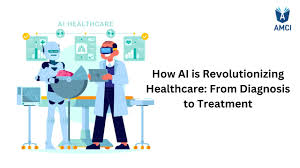
Artificial Intelligence (AI) is transforming healthcare, especially in medical diagnosis, where accurate and timely detection of diseases can save lives. By 2025, AI-powered tools are increasingly integrated into clinical practice, assisting doctors in diagnosing conditions faster, more accurately, and sometimes earlier than ever before.
This revolution is reshaping patient care, improving outcomes, and reducing healthcare costs. Let’s explore how AI is revolutionizing medical diagnosis and what the future holds.
1. AI’s Role in Medical Imaging
One of AI’s most impactful applications is analyzing medical images such as X-rays, MRIs, CT scans, and ultrasounds. Machine learning algorithms can:
- Detect anomalies like tumors, fractures, or infections with high accuracy.
- Highlight areas of concern for radiologists, reducing oversight.
- Speed up image interpretation, enabling quicker treatment decisions.
This helps overcome human limitations and accelerates diagnosis.
2. Predictive Analytics for Early Detection
AI systems analyze patient data—including medical history, genetics, and lifestyle—to predict disease risks and detect early signs. Examples include:
- Predicting heart disease, diabetes, and cancer risks.
- Identifying patterns signaling the onset of neurological disorders.
- Monitoring chronic conditions to prevent complications.
Early diagnosis enables preventive care and personalized treatment plans.
3. Natural Language Processing (NLP) in Clinical Notes
NLP algorithms extract valuable insights from unstructured clinical notes, lab reports, and medical literature by:
- Summarizing patient records to assist decision-making.
- Flagging inconsistencies or missing information.
- Helping doctors stay updated with latest research.
This reduces administrative burden and supports comprehensive diagnosis.
4. AI-Powered Diagnostic Tools and Devices
Innovative devices combine AI with sensors and wearable tech to:
- Monitor vital signs continuously.
- Detect irregular heart rhythms or glucose levels in real-time.
- Provide remote diagnostic support in underserved areas.
These tools expand access to healthcare and enable timely interventions.
5. Challenges and Ethical Considerations
Despite its promise, AI diagnosis faces hurdles:
- Ensuring data privacy and security.
- Avoiding biases in training data that could lead to misdiagnosis.
- Validating AI tools through rigorous clinical trials.
- Maintaining the doctor-patient relationship and accountability.
Ethical frameworks and regulations are essential for responsible AI use.
6. The Future of AI in Medical Diagnosis
Looking ahead:
- AI will increasingly assist rather than replace clinicians.
- Integration with telemedicine will broaden reach.
- Continuous learning systems will adapt to new diseases and treatments.
- Collaborative AI-human diagnosis will enhance accuracy and patient trust.
The synergy of AI and healthcare professionals promises improved health outcomes worldwide.
Final Thoughts
AI is revolutionizing medical diagnosis by enhancing accuracy, speed, and accessibility. While challenges remain, its integration into healthcare systems is inevitable and transformative.
By embracing AI responsibly, the future of diagnosis will be more precise, personalized, and proactive—ultimately saving more lives.